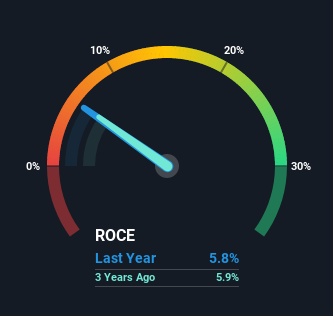Return Trends At Vector (NZSE:VCT) Aren't Appealing
If we want to find a potential multi-bagger, often there are underlying trends that can provide clues. Typically, we'll want to notice a trend of growing return on capital employed (ROCE) and alongside that, an expanding base of capital employed. Put simply, these types of businesses are compounding machines, meaning they are continually reinvesting their earnings at ever-higher rates of return. Although, when we looked at Vector (NZSE:VCT), it didn't seem to tick all of these boxes.
Return On Capital Employed (ROCE): What is it?
For those that aren't sure what ROCE is, it measures the amount of pre-tax profits a company can generate from the capital employed in its business. Analysts use this formula to calculate it for Vector:
Return on Capital Employed = Earnings Before Interest and Tax (EBIT) ÷ (Total Assets - Current Liabilities)
0.058 = NZ$328m ÷ (NZ$6.4b - NZ$748m) (Based on the trailing twelve months to December 2020).
So, Vector has an ROCE of 5.8%. In absolute terms, that's a low return, but it's much better than the Integrated Utilities industry average of 4.8%.
Check out our latest analysis for Vector
Above you can see how the current ROCE for Vector compares to its prior returns on capital, but there's only so much you can tell from the past. If you're interested, you can view the analysts predictions in our free report on analyst forecasts for the company.
What The Trend Of ROCE Can Tell Us
Things have been pretty stable at Vector, with its capital employed and returns on that capital staying somewhat the same for the last five years. Businesses with these traits tend to be mature and steady operations because they're past the growth phase. With that in mind, unless investment picks up again in the future, we wouldn't expect Vector to be a multi-bagger going forward. That being the case, it makes sense that Vector has been paying out 122% of its earnings to its shareholders. Most shareholders probably know this and own the stock for its dividend.
The Bottom Line
We can conclude that in regards to Vector's returns on capital employed and the trends, there isn't much change to report on. Since the stock has gained an impressive 55% over the last five years, investors must think there's better things to come. However, unless these underlying trends turn more positive, we wouldn't get our hopes up too high.
One more thing, we've spotted 2 warning signs facing Vector that you might find interesting.
While Vector isn't earning the highest return, check out this free list of companies that are earning high returns on equity with solid balance sheets.
This article by Simply Wall St is general in nature. It does not constitute a recommendation to buy or sell any stock, and does not take account of your objectives, or your financial situation. We aim to bring you long-term focused analysis driven by fundamental data. Note that our analysis may not factor in the latest price-sensitive company announcements or qualitative material. Simply Wall St has no position in any stocks mentioned.
Have feedback on this article? Concerned about the content? Get in touch with us directly. Alternatively, email editorial-team (at) simplywallst.com.

 Yahoo Finance
Yahoo Finance 
